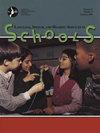语言病理学家对双语儿童语言评价的看法。
IF 2.9
3区 医学
Q1 AUDIOLOGY & SPEECH-LANGUAGE PATHOLOGY
Language Speech and Hearing Services in Schools
Pub Date : 2025-04-10
DOI:10.1044/2025_lshss-24-00145
引用次数: 0
摘要
目的:本研究采用半结构化的开放式访谈方法,从学校语言病理学家(slp)那里收集有关他们对疑似语言障碍的双语儿童进行评估的信息。方法对美国25所学校的slp进行电话访谈。访谈探讨了与工具选择和基本原理以及评估数据的整合相关的评估主题,以确定诊断和治疗资格。结果本研究结果表明,语言服务提供者在评估双语儿童时使用规范参考和非正式评估相结合的方法。非正式的措施,如家长/教师访谈和语言抽样,依赖于诊断决策,与以往研究中观察到的对规范参考测试的强调形成对比。地区政策和指导方针影响了参照标准的评估。非正式工具用于捕捉自然语言的使用,提供双语能力的全面视图,并收集详细的案例历史。结论:以学校为基础的特殊教育项目在其双语评估实践中整合了规范参考和非正式措施,在诊断决策中明显依赖非正式评估。这种方法与单语评估实践中通常观察到的对规范参考措施的依赖形成对比,反映了slp在使用双语儿童时对规范参考测试的局限性和偏见的潜在认识。研究结果表明,slp意识到并使用具有文化敏感性的诊断方法。本文章由计算机程序翻译,如有差异,请以英文原文为准。
Speech-Language Pathologists' Perspectives on Language Assessment in Bilingual Children.
PURPOSE
This study used a semistructured open interview approach to gather information from school-based speech-language pathologists (SLPs) regarding their assessment practices for bilingual children with suspected language disorders.
METHOD
Phone interviews were conducted with 25 school-based SLPs across the United States. The interviews explored assessment topics related to tool selection and rationale and the integration of assessment data to determine diagnosis and treatment eligibility.
RESULTS
The results of this study suggest that SLPs use a combination of norm-referenced and informal assessments when evaluating bilingual children. Informal measures, such as parent/teacher interviews and language sampling, were relied upon for diagnostic decisions, contrasting with the emphasis on norm-referenced testing observed in previous research. District policies and guidelines influenced norm-referenced assessments. Informal tools were used to capture natural language use, provide a comprehensive view of bilingual abilities, and gather detailed case histories.
CONCLUSIONS
School-based SLPs integrate norm-referenced and informal measures in their bilingual assessment practices, with a notable reliance on informal assessments for diagnostic decision making. This approach contrasts with the reliance on norm-referenced measures typically observed in monolingual assessment practices, reflecting SLPs' potential recognition of limitations and biases in norm-referenced tests when used with bilingual children. The findings suggest that SLPs are aware of and use culturally sensitive diagnostic practices.
求助全文
通过发布文献求助,成功后即可免费获取论文全文。
去求助
来源期刊

Language Speech and Hearing Services in Schools
Social Sciences-Linguistics and Language
CiteScore
4.40
自引率
12.50%
发文量
165
期刊介绍:
Mission: LSHSS publishes peer-reviewed research and other scholarly articles pertaining to the practice of audiology and speech-language pathology in the schools, focusing on children and adolescents. The journal is an international outlet for clinical research and is designed to promote development and analysis of approaches concerning the delivery of services to the school-aged population. LSHSS seeks to advance evidence-based practice by disseminating the results of new studies as well as providing a forum for critical reviews and meta-analyses of previously published work.
Scope: The broad field of audiology and speech-language pathology as practiced in schools, including aural rehabilitation; augmentative and alternative communication; childhood apraxia of speech; classroom acoustics; cognitive impairment; craniofacial disorders; fluency disorders; hearing-assistive technology; language disorders; literacy disorders including reading, writing, and spelling; motor speech disorders; speech sound disorders; swallowing, dysphagia, and feeding disorders; voice disorders.
 求助内容:
求助内容: 应助结果提醒方式:
应助结果提醒方式:


